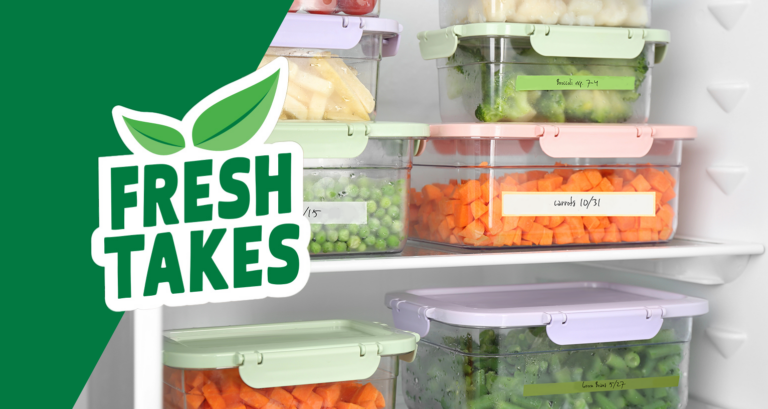Freezing isn’t just for winter — it’s a smart way to save time and money while reducing food waste. Below we’ll share Fresh Takes on how to freeze effectively, keeping foods fresh and meals ready in a pinch. With the right freezing techniques, you can extend the life of leftovers by up to six months, helping your household reduce food waste and save money.
PRACTICAL TIPS FOR FREEZING FOOD
- Freeze at Peak Freshness: Always freeze foods when they’re at their best.
- Cool Down First: Let cooked foods cool completely before freezing to avoid freezer burn.
- Blanch Vegetables: Briefly boil veggies, then cool in an ice bath before freezing to preserve quality.
- Portion Control: Freeze meals in single servings for easier thawing and less waste.
- Use Proper Packaging: Airtight containers or freezer bags prevent freezer burn.
- Label and Date: Always label frozen foods to track their storage time. Freezing your food not only helps you save money but also reduces waste and saves valuable resources. Food waste consumes a significant amount of water — an often-overlooked cost of throwing out uneaten food. By freezing meals instead of tossing leftovers, you’re making a meaningful impact on both your budget and the planet.
FRESH TAKES: FREEZE FOODS FOR QUICK MEALS
Blueberry Banana Muffins: Bake ahead and freeze extras for an easy breakfast or snack.
MAKE SHOPPING EASY WITH A LIST
Click here to view the Fresh Takes suggested February shopping list.
HOW TO PROPERLY FREEZE FOODs
- Fruits: Rinse, dry and freeze fruit whole or in slices in an airtight container. Smaller fruits like berries can be frozen on a sheet pan to avoid clumping.
Vegetables: Blanch before freezing in an airtight container. Avoid freezing leafy greens. Water-heavy vegetables, like tomatoes, can be frozen, but the texture may be affected, and are best used in sauces or stews. - Herbs: Wash, dry and chop herbs, mix with water or olive oil and freeze in ice cube trays.
- Dairy: Leave space for expansion when freezing. Hard cheeses wrapped in parchment can be frozen in an airtight container. Freezing soft cheeses alters their texture but they can still be used for cooking.
- Soups and Stews: Cool fully, then freeze in airtight containers or freezer bags.
- Baked Goods: Place cooled baked goods in a container or freezer bag to keep them fresh in the freezer. Slice bread first to easily grab a few slices as you need them.
Download our Food Storage Guide for a fresh take on storing common foods for optimal freshness, so you waste less and enjoy more.
Optimize Your Freezer for Success
Keep your freezer at 0°F or below and organize it for easy access. While frozen foods stay safe for up to six months, label and date them to ensure the best quality. A little planning goes a long way in making freezing your go-to solution for saving time, money and resources.
_____________________________
Freezing food the right way helps you save time, money and reduce food waste — it’s a simple change that makes a big difference. For more freezer-friendly recipes, money-saving hacks and tips to reduce food waste, explore more Fresh Takes at savemorethanfood.org/freshtakes.


